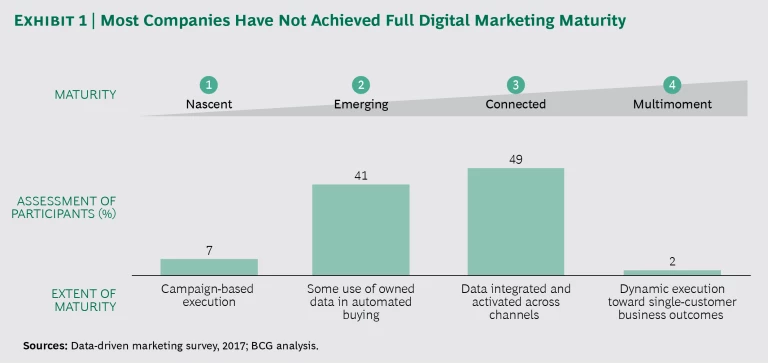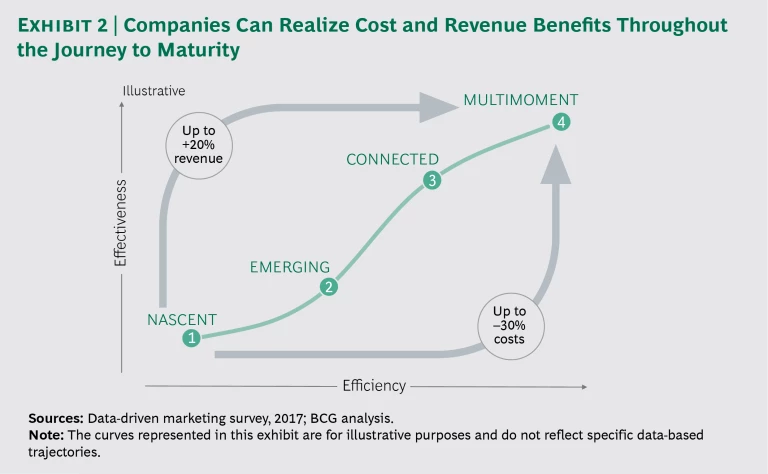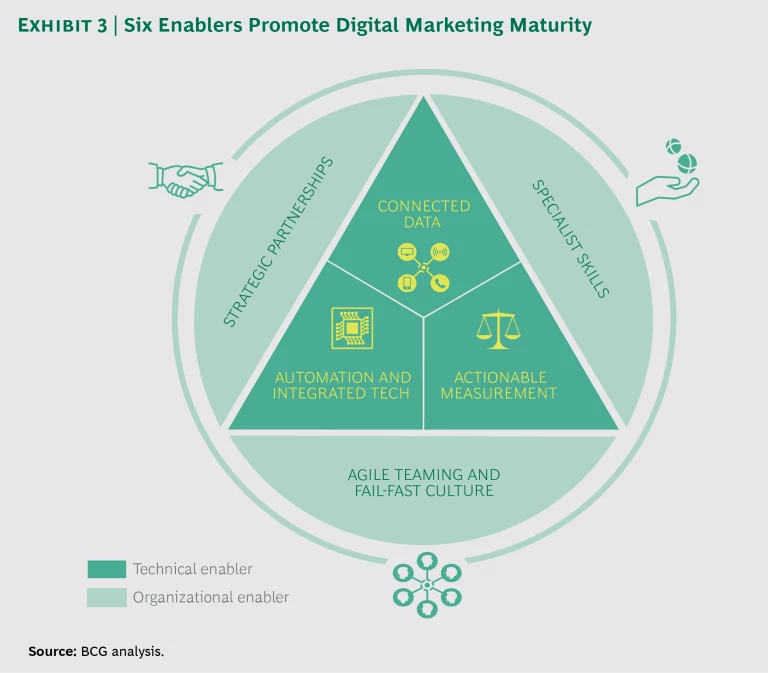Customer journeys. Omnichannel interactions. Programmatic. Personalization. The buzzwords of digital marketing fly around corporate meeting rooms, C-suites, conference calls, and webinars these days, often at dizzying velocity. But while just about every company talks the digital talk, relatively few walk an actual data-driven digital walk. The promise of digital marketing is great, but the practice is extremely hard.
Many issues contribute to the difficulty, starting with technical ones. Most marketers are not mathematicians, much less data scientists. They don’t have technology in place to collect and use data, and they don’t know how to ensure that the technology they do have is properly wired together and capable of measuring impact (online and offline), preferably by demonstrating causality. The organizational challenges are just as daunting. Agile is easier to talk about than to implement. Cross-functional collaboration does not come readily to most organizations. Digital marketing involves new ways of working, and these ways affect every staff member personally, from job description to office location to compensation. People and organizations tend to resist this kind of change, especially when it impacts their own future.
BCG and Google have collaborated multiple times over the past few years to study various aspects of digital marketing.
- What does best practice look like?
- What is the road map to best practice?
- What value does improving your capabilities drive?
We conducted a study consisting of three phases: a series of workshops and interviews to define a digital marketing maturity framework , “belief audits” with about 40 experts to test the framework and the enablers that support it, and a survey of senior marketers from more than 40 brands in eight industries across Europe who quantified the importance of the enablers and the levels of maturity of the participating companies. We identified six enablers that companies need to acquire or develop if they are to track customer journeys, engage customers through multiple channels at opportune times, and develop personalized relationships and interactions. We used the results to develop a road map to guide marketers along the digital marketing maturity curve.
Wide Disparities and High Barriers
Consumers today expect digital engagement. Sophisticated digital marketers, such as Amazon, Netflix, and Starbucks, have trained them to anticipate outreach, interaction, and even personalized offers, online and offline, from brands and retailers. For many marketers, however, using data for end-to-end tracking and targeting remains an unfulfilled promise. They lack in-depth understanding of end-to-end customer journeys, and they struggle with decisions about how and where to coordinate and focus their engagement efforts.
Levels of digital maturity vary considerably among marketing organizations—as do the results that marketers achieve. Companies tend to fall into one of four maturity levels (or really one of three, since few companies have reached full digital maturity yet):
- Nascent. Marketing campaigns mainly use external data and direct buys, with limited linkage to sales.
- Emerging. Marketers make some use of owned data in automated buying, with single-channel optimization and testing.
- Connected. Marketers rely on data integrated and activated across channels, with demonstrated linkage to ROI or sales proxies.
- Multimoment. The organization optimizes dynamic execution across channels toward single-customer business outcomes.
Of the 40 companies from multiple industries that we studied, 90% were split almost equally between the emerging and connected categories. (See Exhibit 1.) Clearly marketers are trying to climb the digital curve, but the curve gets steeper as it rises, increasing the difficulty of moving to the next level. And multiple barriers hinder companies’ efforts to achieve multimoment maturity—the ability to deliver personalized content to consumers at multiple moments across the purchase journey.
The companies in our study wrestled with both technical and organizational issues:
- 83% could not link data across consumer touch points.
- 68% lacked automation, relying instead on manual processes.
- 78% could not attribute value to their individual touch points with consumers.
- 80% suffered from inadequate cross-functional coordination.
Many organizations fail to make a full transition to digital. Instead, they try to force data-driven and digital ways of working into their existing paradigms, or they refuse to make the tough decisions about positions, roles, and functions that underpin a full digital transformation. Companies that climb the digital maturity curve, however, can achieve impressive results: they report cost savings of up to 30% and revenue increases of as much as 20%. (See Exhibit 2.)
Six Enablers of Digital Marketing Maturity
In studying the barriers to success, we identified six factors that enable a company to navigate the maturity curve. (See Exhibit 3.) The first three enablers are technical and the remaining three are organizational. All are essential if a company is to reach multimoment maturity.
Connected Data. Mature marketers can link all of a company’s data sources, online and offline, to build a complete customer picture. In the digital age, connected data is essential, not only to marketing but also to applying new technologies to a host of business needs and functions. For example, the finance subsidiary of a large European retailer established a unified data platform for the company’s 16 million loyalty program members. The platform houses company data (from transactions and onsite and offsite activity) and third-party data in one place. The finance company has halved the online credit card application journey from eight screens to three, and it now offers differentiated products, including price-advantaged loans, to program members.
Automation and Integrated Tech. Companies today need an array of marketing technology tools that permit automation of data and content at scale. The required tools include a web analytics capability, a CRM suite, integrated advertising technology, and automation tools for message tailoring. These technologies open a world of possibilities. A major international retailer that sells both online and offline used its technology suite to segregate its accounts by device type and to apply geotargeting tools to trigger contact based on customers’ store proximity. It also launched adaptive shopping campaigns that categorize products by their return on advertising spending (ROAS), leading to a 68% increase in ROAS, a 114% increase in online revenue, and a 232% increase in store visits.
Actionable Measurement. Data-driven marketers can identify the value of each touch point with consumers along the purchasing journey to inform KPIs and link these engagements to business outcomes such as sales and profit impact. These marketers know what their customers are thinking about, where they stand on the purchasing journey, and why they buy what they buy. An office equipment retailer uses a conversion API and custom attribution models to combine online data and offline transaction activity into a unified omnichannel report that clarifies how digital campaigns perform in-store as well as online. An online fashion retailer often tests incremental sales by channel to evaluate how each channel contributes to the value of each customer over an extended period. This analysis enables the company to better segment its customers and more effectively target marketing spending and outreach activities.
Strategic Partnerships. Technology is about ecosystems. Few companies, even digital natives, go it alone. The key for marketers is to collaborate effectively with agencies and marketing tech providers while maintaining ownership of technology and data. One automaker has established a marketing hothouse where about 150 people, including staff from four agency partners, work in the same building alongside members of the OEM’s marketing and media teams. This approach puts all the expert disciplines (creative, content, operational, social media, and others) in a single place. The company has standardized ways for its agencies and marketing team to collaborate on campaign development, including performance reviews against predefined shared marketing objectives, as well as budget, quality, and timeliness criteria. Among the resulting benefits is increased agility with improved capacity planning and speed to output.
Specialist Skills. It’s one thing to identify, hire, and train technical talent, such as in-house data scientists and measurement experts; it’s quite another to integrate these people with other members of the marketing staff to produce effective cross-functional teams. The lack of organizational connection between branding and online marketing staffs led one online retailer to establish multidisciplinary marketing teams in which experts could work together closely to create one experience for customers. Each team includes specialists in brand marketing communications, customer insights, shop management, programmatic advertising, shop marketing, and marketing intelligence (data scientists), who advise the rest of the team on data and performance.
Agile Teaming and Establishing a Fail-Fast Culture. Done right, an agile transformation affects everything from internal processes to how employees spend their day to how people in the organization interact. It requires rethinking structures, reporting, compensation, and career paths. Since most established organizations favor the status quo and fear change, it is not unusual for them to try to kill the transformation before it can gain traction. To prevent this from happening, C-suite sponsorship is essential, as is the active cooperation and, often, physical presence of corporate functions such as HR, legal, and finance. At the same time, however, marketers need to embrace a fail-fast test-and-learn approach in which they identify failures early, learn the appropriate lessons, and move on. For most companies, making the agile transformation is the most difficult step to take—but it’s also the one that brings all of the others together.
Time to Get Started
Aside from digital natives, no company goes digital overnight, or even in a matter of weeks or months. Just as digital technology functions differently from legacy systems, digital ways of working are unlike those of traditional organizations. Both technological and organizational factors make the transition from old to new difficult and time consuming. Marketing organizations that want to make the shift should expect a lengthy journey.
On this trip, as on any other, having a road map helps. On the basis of our research, we have identified a pathway for acquiring or developing digital enablers that will move a company forward on the maturity curve. The road map has three stages, and—as with the enabling factors—there are both technical and organizational milestones to achieve at each stage. Smart companies find quick moves that they can make at each stage, often while using existing data capabilities and technology, to show early progress, thus building momentum, forcing practicality, and helping fund the journey to the next stage. One way to demonstrate an early win is to focus on mastering one channel and driving cost out of poor execution. Companies can also pilot, demonstrate, and scale up these moves quickly.
From Nascent to Emerging: Set the Foundation. One reason the transition to digital marketing is hard is that it involves changing how people work. Such a transition requires an active and visible C-suite sponsor. It also demands the active involvement and cooperation of internal and external partners. HR must help design new career paths and incentive schemes, for example. Legal must agree to new ways of reviewing and approving campaigns. The company will probably have to bring external agencies and their expertise on board to fill gaps in internal capability (although, ironically, this is often easier than securing internal cooperation).
On the technical side, companies need to come to grips with their current data situation and their ability (or inability) to turn data into actionable insights and campaigns. Data is the foundation for digital engagement and personalization, but many marketing organizations lack regular access to either data on customer-level purchase behavior and characteristics or online metrics (such as clicks on websites, page views, and conversions). Furthermore, they lack the robust analytical capabilities that can turn data into plans, programs, and initiatives. Without such data-related capabilities, they have little hope of reaching the next stage: becoming connected.
From Emerging to Connected: Build Connections. The second stage of the journey to digital maturity involves building the cross-functional connections that make digital organizations work. Companies can demonstrate progress by starting to coordinate multiple channels, drive incremental revenue, and achieve efficiencies through better media execution.
Most successful companies establish cross-functional teams (which they will need in any event when they move to the next maturity stage) that combine the relevant expert disciplines—creative, content, operational, and social media, for example—and bring together offline channel and online marketing to work more closely together. Some put their teams in the same location, as the automaker did in establishing its cross-functional hothouse. These teams work toward common KPIs.
Crucial at this stage are the technical abilities to combine internal and external sources of online data to provide insights about audiences and to inform creative work, and then to automate messages for fast campaign development, testing, and adjustment. Another auto OEM uses data-driven targeting and automated activation in a campaign that demonstrates various car configurations and delivers more than 6,000 automated creative treatments on the basis of consumers’ configurator preferences. The resulting ads have achieved conversion rates that are four times as high as those for traditional ads, with double the efficiency. A UK retailer aligns its search-ad content with changes in its available stock to improve advertising efficiency by reducing wasted clicks and driving a greater proportion of qualified traffic. The company has seen a 26% increase in lead volume, a 53% reduction in cost per lead, and a 50% decrease in cost per click.
From Connected to Multimoment: Make Every Moment Count. The final stage of marketing maturity is the most difficult. Acting on each customer touch point in a coordinated and sequenced way involves integrating key proprietary capabilities into the organization and also embedding agile teaming, without which moving at digital speeds is virtually impossible. This is where many companies stumble, leaving them with an organization that is agile in name only or that has adopted half measures. They may be successful at cross-functional reorganization, for example, but fall short in following through with redesigned career paths and shared-objective-based incentive programs. They may have a bank of data scientists and measurement experts, but fail to use data-driven decision making. Companies that get agile right start to market across channels and deliver better, more personalized customer experiences that drive sales. At the same time, their use of more sophisticated tech and automation lowers costs.
It’s essential at this stage to link technology objectives to business-outcome KPIs and to use sophisticated attribution, among other measurement techniques, to optimize value. A global restaurant franchise company links offline sales to online marketing through a combination of third-party customer footfall data as a proxy for sales and geolocation data. A UK retailer has developed a strategic measurement plan to understand behavior and identify opportunities as a basis for deriving fast, accurate insights to inform real-time decisions.
Big Change, Big Rewards
The necessary changes are hard, but the rewards are big. The benefits, like the capabilities themselves, come in stages. The early years of the journey are likely to see cost savings accrue as companies learn to use the power of automation to streamline previously manual processes, eliminate wasted effort, and boost efficiency. The company can allow the money saved to drop to the bottom line, or it can reinvest that money to build new capabilities and fund additional effective campaigns. During the later years, the investments in expertise and enablers will pay off with the ability to mount personalized campaigns at scale and build customer relationships that deliver increased loyalty and revenue.
They say growing up is hard to do—and when it comes to digital marketing, they are right. But maturity has its advantages. The sooner marketers start (or accelerate) their journey to digital maturity, the sooner they will see the benefits to their business accrue.












